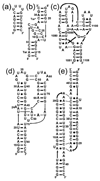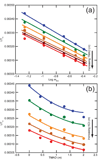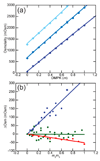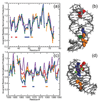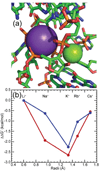The osmolyte TMAO stabilizes native RNA tertiary structures in the absence of Mg2+: evidence for a large barrier to folding from phosphate dehydration - PubMed (original) (raw)
The osmolyte TMAO stabilizes native RNA tertiary structures in the absence of Mg2+: evidence for a large barrier to folding from phosphate dehydration
Dominic Lambert et al. J Mol Biol. 2010.
Abstract
The stabilization of RNA tertiary structures by ions is well known, but the neutral osmolyte trimethylamine oxide (TMAO) can also effectively stabilize RNA tertiary structure. To begin to understand the physical basis for the effects of TMAO on RNA, we have quantitated the TMAO-induced stabilization of five RNAs with known structures. So-called m values, the increment in unfolding free energy per molal of osmolyte at constant KCl activity, are ∼0 for a hairpin secondary structure and between 0.70 and 1.85 kcal mol(-1)m(-1) for four RNA tertiary structures (30-86 nt). Further analysis of two RNAs by small-angle X-ray scattering and hydroxyl radical probing shows that TMAO reduces the radius of gyration of the unfolded ensemble to the same endpoint as seen in titration with Mg(2+) and that the structures stabilized by TMAO and Mg(2+) are indistinguishable. Remarkably, TMAO induces the native conformation of a Mg(2+) ion chelation site formed in part by a buried phosphate, even though Mg(2+) is absent. TMAO interacts weakly, if at all, with KCl, ruling out the possibility that TMAO stabilizes RNA indirectly by increasing salt activity. TMAO is, however, strongly excluded from the vicinity of dimethylphosphate (unfavorable interaction free energy, +211 cal mol(-1)m(-1) for the potassium salt), an ion that mimics the RNA backbone phosphate. We suggest that formation of RNA tertiary structure is accompanied by substantial phosphate dehydration (loss of 66-173 water molecules in the RNA structures studied) and that TMAO works principally by reducing the energetic penalty associated with this dehydration. The strong parallels we find between the effects of TMAO and Mg(2+) suggest that RNA sequence is more important than specific ion interactions in specifying the native structure.
Copyright © 2010 Elsevier Ltd. All rights reserved.
Figures
Figure 1
Schematics of the secondary and tertiary structures of the RNAs used in this study. Horizontal black bars and bullets represent Watson-Crick and non-canonical base pairs, respectively. Gray lines symbolize base-base tertiary interactions and black lines with arrow-heads represent 5’-3’ backbone connectivity. (a) A designed hairpin. (b) The tar-tar* kissing-loops complex. (c) Nucleotides 1051–1108 of the E. coli 16S rRNA, with a mutation (U1061A) that stabilizes tertiary structure (58mer RNA). (d) The aptamer domain of the adenine-binding riboswitch with adenine ligand depicted in outline typeface (A-riboswitch). (e) The tetraloop-receptor RNA (TLR).
Figure 2
Salt and TMAO dependences of tertiary structure stability of the A-riboswitch aptamer domain, plotted as (1/Tm) obtained from melting experiments. The two panels show the same set of 30 different conditions. The drawn curves are least squares best fits all derived from the same three dimensional surface specified by six fitting parameters (see Materials and Methods). (a) KCl dependence at fixed TMAO concentrations: blue, no TMAO; green, 0.4 m; orange, 0.8 m; brown, 1.284 m, dark brown, 1.6 m; red, 2.0 m. (b) Data from panel A replotted to show TMAO dependence at fixed K+ concentrations: blue, 54 m_m_; green, 104 m_m_; orange, 204 m_m_; brown, 304 m_m_; red, 404 m_m_. Each melt sample contained 50 mm KMOPS pH 7.0, 5 µ_m_ DAP and 2 µ_m_ EDTA along with additional KCl and TMAO to give the indicated concentrations. Errors bars are smaller than the size of data points.
Figure 3
Melt profiles of 58mer RNA in various TMAO and salt concentrations. A) Data sets were collected at 260 (blue) and 280 (red) nm in buffer containing 400 m_m_ K+, 2 µ_m_ EDTA and either 100 m_m_ K-MOPS pH 6.8 with 4 m TMAO (light shades), or 160 m_m_ K-MOPS pH 6.8 and 6 m TMAO (dark shades). B) Data were collected at 260 (blue), 280 (red), and 295 (purple) nm in the presence of 52.4 m_m_ K+, 2 µ_m_ EDTA, 182 m_m_ K-MOPS and 7.7 m TMAO. Arrows indicate the change in ratio of absorbance at 260/280nm (A) or 295nm signal (B) corresponding to melting of tertiary structure.
Figure 4
Vapor Pressure Osmometry (VPO) measurements and analysis. (a) Osmolality of potassium dimethylphosphate (K-DMP) with (from bottom to top) 0, 0.5, or 1.0 m TMAO. Fitted curves are second order polynomials. Error bars are shown, but are generally smaller than the data points. (b) The non-additivity of TMAO and solute osmolalities (ΔOsm) plotted according to eqs 7–8. Lines are linear least squares fits; the slopes are reported in Table 3 as μ23/RT. Blue, TMAO and K-DMAP; green, TMAO and KCl; red, TMAO and glycerol.
Figure 5
Dimensions of A-riboswitch and 58mer RNAs at various TMAO and Mg2+ concentrations, as determined by SAXS. (a) Rg of the A-riboswitch wildtype sequence (red) and two folding-impaired variants, C60G (orange) and G28C (green), in 182 m_m_ KMOPS pH 6.8, 2 µ_m_ EDTA, 50 m_m_ K+, and various molalities of TMAO. For comparison purposes, Rg in the same buffer containing 1 mM Mg2+ (black point) is also indicated. (b) Distance distribution functions of the A-riboswitch with 8 m TMAO (red) or 1m_m_ Mg2+ (black), and of the G38C (green) and C60G variants (orange) with 8 m TMAO. Other buffer components are the same as in panel (a). (c) Rg of the 58mer RNA (blue) in 182 m_m_ MOPS pH 6.8, 2 µ_m_ EDTA, 50 m_m_ K+, and various molalities of TMAO. For comparison purposes, Rg in the same buffer containing 0.1m_m_ Mg2+ (black) is also indicated. In both panels (a) and (c), error bars are smaller than the size of the data points. (d) Distance distribution function of the 58mer rRNA in 2 m TMAO (light blue), 4 m TMAO (medium blue), 8 m (dark blue), and 0.1 m_m_ Mg2+ (black). Other buffer components are the same as in panel (c).
Figure 6
Normalized data for the reactivity of the A-riboswitch (a, b) and 58mer rRNA fragment (c, d) towards hydroxyl radical. Gel band intensities have been normalized as described (Materials and Methods). (a) Reactivity of the A-riboswitch was assayed in K-MOPS buffer pH 6.8, 50 m_m_ K+ plus no TMAO (purple); 5 m TMAO (yellow); 8 m TMAO (green) or 5 m_m_ MgCl2 (blue). MOPS anion concentrations were 20 m_m_ (no TMAO or MgCl2), 125 m_m_ (5 m TMAO) or 182 m_m_ (8 m TMAO). Regions of increased protection compared to the unfolded conformation are indicated by colored bars corresponding to residues depicted in panel (b). (b) Residues protected from hydroxyl radical displayed on the A-riboswitch crystal structure (1Y26) where residues 33, 37 and 38 are colored in red, 46 to 49 are displayed in blue, and 52 and 53 are shown in yellow. The adenine ligand is depicted in green. (c) Reactivity of the 58mer RNA obtained in K-MOPS buffer pH 6.8, 60 mM K+ plus no TMAO (purple); 4 m TMAO (red), 5 m TMAO (yellow), 8_m_ TMAO (green); or 5 m_m_ MgCl2 (blue). MOPS anion concentrations were 20 m_m_ (no TMAO or MgCl2), 100 m_m_ (4 m TMAO) 125 m_m_ (5 m TMAO) or 182 m_m_ (8 m TMAO). Regions of increased protection compared to the unfolded conformation are indicated by colored bars corresponding to residues depicted in panel (d). (d) Representation of residues protected from hydroxyl radical on the 58mer rRNA crystal structure (1HC8) where residues 18 to 21 are colored in red, 35 to 37 are depicted in blue and 45 to 47 are indicated in yellow. Residues 14 in the 58mer and 66 in the A-riboswitch were impossible to quantify accurately and were not plotted. Protection assessments for residues at the 3’end, which correspond nucleotides at the bottom of the gel, were also unreliable.
Figure 7
The 58mer RNA ion-binding pocket confers a specific monovalent ion requirement for optimal stability. (a) View of the crystal structure of the 58mer RNA (1HC8) regions surrounding chelated K+ (violet sphere) and Mg2+ (green sphere) ions. Anionic oxygens of A1073 contact either the K+ or Mg2+ ion. (b) Relative free energy changes for folding the 58mer rRNA fragment with either 0.5 mM MgCl2 (blue) or 6 m TMAO (red) added to buffer with different group I ions (1 m M+, 150 m_m_ M-MOPS pH 6.8, 2 µ_m_ EDTA). The ionic radii are taken from Pauling.
Figure 8
Solvent accessible surface areas (SASA) of phosphates groups for four RNAs with tertiary structure (Figure 1). (a) 58mer rRNA (1HC8), (b) the two monomers from the tetraloop-receptor RNA complex (2JYF), (c) A-riboswitch (1Y26), and (d) Tar-tar* (1KIS). Blue data points indicates SASA obtained with a probe radius of 1.4 Å whereas red points correspond to a probe radius of 2.8 Å.
Figure 9
Contrasting mechanisms by which Mg2+ and TMAO may stabilize the same RNA tertiary structure. The relative free energy (chemical potential) of folded (F) and unfolded (U) forms of a hypothetical RNA tertiary structure are diagrammed. In buffer, the U form of the RNA is represented as more stable than F (black boxes; the observed folding free energy, ΔG°obs, is positive). Mg2+ interacts strongly (red arrows) with both U and F forms of the RNA, but preferentially stabilizes the native structure (red boxes; ΔG°obs is now negative). TMAO interactions with both U and F forms are strongly unfavorable (blue arrows), but the U form is more strongly affected because of its more extensive exposure of phosphates to solvent. Therefore ΔG°obs becomes negative (blue boxes).
Similar articles
- Protonation of trimethylamine N-oxide (TMAO) is required for stabilization of RNA tertiary structure.
Denning EJ, Thirumalai D, MacKerell AD Jr. Denning EJ, et al. Biophys Chem. 2013 Dec 31;184:8-16. doi: 10.1016/j.bpc.2013.08.002. Epub 2013 Aug 17. Biophys Chem. 2013. PMID: 24012912 Free PMC article. - Effects of Mg2+ on the free energy landscape for folding a purine riboswitch RNA.
Leipply D, Draper DE. Leipply D, et al. Biochemistry. 2011 Apr 12;50(14):2790-9. doi: 10.1021/bi101948k. Epub 2011 Mar 21. Biochemistry. 2011. PMID: 21361309 Free PMC article. - TMAO Destabilizes RNA Secondary Structure via Direct Hydrogen Bond Interactions.
Cho SS, Green AT, Hyeon C, Thirumalai D. Cho SS, et al. J Phys Chem B. 2023 Jan 19;127(2):438-445. doi: 10.1021/acs.jpcb.2c05434. Epub 2023 Jan 5. J Phys Chem B. 2023. PMID: 36602908 - A guide to ions and RNA structure.
Draper DE. Draper DE. RNA. 2004 Mar;10(3):335-43. doi: 10.1261/rna.5205404. RNA. 2004. PMID: 14970378 Free PMC article. Review. - Folding of RNA tertiary structure: Linkages between backbone phosphates, ions, and water.
Draper DE. Draper DE. Biopolymers. 2013 Dec;99(12):1105-13. doi: 10.1002/bip.22249. Biopolymers. 2013. PMID: 23568785 Free PMC article. Review.
Cited by
- Denaturation of RNA secondary and tertiary structure by urea: simple unfolded state models and free energy parameters account for measured m-values.
Lambert D, Draper DE. Lambert D, et al. Biochemistry. 2012 Nov 6;51(44):9014-26. doi: 10.1021/bi301103j. Epub 2012 Oct 29. Biochemistry. 2012. PMID: 23088364 Free PMC article. - Probing the protein-folding mechanism using denaturant and temperature effects on rate constants.
Guinn EJ, Kontur WS, Tsodikov OV, Shkel I, Record MT Jr. Guinn EJ, et al. Proc Natl Acad Sci U S A. 2013 Oct 15;110(42):16784-9. doi: 10.1073/pnas.1311948110. Epub 2013 Sep 16. Proc Natl Acad Sci U S A. 2013. PMID: 24043778 Free PMC article. - Mammalian RNA switches: Molecular rheostats in gene regulation, disease, and medicine.
Venkata Subbaiah KC, Hedaya O, Wu J, Jiang F, Yao P. Venkata Subbaiah KC, et al. Comput Struct Biotechnol J. 2019 Oct 24;17:1326-1338. doi: 10.1016/j.csbj.2019.10.001. eCollection 2019. Comput Struct Biotechnol J. 2019. PMID: 31741723 Free PMC article. Review. - Pursuing origins of (poly)ethylene glycol-induced G-quadruplex structural modulations.
Trajkovski M, Endoh T, Tateishi-Karimata H, Ohyama T, Tanaka S, Plavec J, Sugimoto N. Trajkovski M, et al. Nucleic Acids Res. 2018 May 4;46(8):4301-4315. doi: 10.1093/nar/gky250. Nucleic Acids Res. 2018. PMID: 29648656 Free PMC article. - Effects of a protecting osmolyte on the ion atmosphere surrounding DNA duplexes.
Blose JM, Pabit SA, Meisburger SP, Li L, Jones CD, Pollack L. Blose JM, et al. Biochemistry. 2011 Oct 11;50(40):8540-7. doi: 10.1021/bi200710m. Epub 2011 Sep 15. Biochemistry. 2011. PMID: 21882885 Free PMC article.
References
- Yancey PH, Clark ME, Hand SC, Bowlus RD, Somero GN. Living with water stress: evolution of osmolyte systems. Science. 1982;217:1214–1222. - PubMed
- Liu Y, Bolen DW. The peptide backbone plays a dominant role in protein stabilization by naturally occurring osmolytes. Biochemistry. 1995;34:12884–12891. - PubMed
- Timasheff SN. Control of protein stability and reactions by weakly interacting cosolvents: the simplicity of the complicated. Adv Protein Chem. 1998;51:355–432. - PubMed
- Courtenay ES, Capp MW, Saecker RM, Record MT., Jr Thermodynamic analysis of interactions between denaturants and protein surface exposed on unfolding: interpretation of urea and guanidinium chloride m-values and their correlation with changes in accessible surface area (ASA) using preferential interaction coefficients and the local-bulk domain model. Proteins Suppl. 2000;4:72–85. - PubMed
Publication types
MeSH terms
Substances
LinkOut - more resources
Full Text Sources
Research Materials
